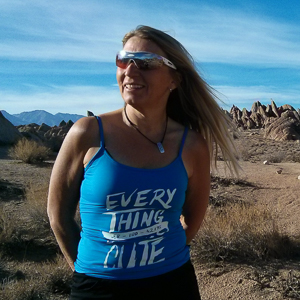
Andrea Helmuth
IRONMAN Lake Tahoe
High Five
I broke my word. Once again. “Finishing four IRONMAN is enough!” I was certain about this. I never ran out of ideas or plans over the last couple of years. Though, one last IRONMAN, my fifth, as sportive challenge in the year of my 50th birthday wouldn’t hurt – unless said IRONMAN turns out to happen on one of the most challenging courses and under extreme conditions in IM history.
Think big
America. California. It’s almost a year ago that I saw the advertising trailer of a new event. I was instantly hooked. It shows the charms of California, the easygoingness – a synonym of everything new and marvelous. Also new is the IRONMAN in Lake Tahoe. I must have over read the small prints, or maybe I just didn’t care in that moment. The course is located at 6.000 ft. with nearly 8000 ft. of climbing on the bike course alone. It leads through the skiing area of the Sierra Nevada and promises a breathtaking (in the true sense of the word) set and landscape for such an event. Think Big: My imagination has reached its limit. IRONMAN Lake Tahoe has currently the highest course of all IM events worldwide (as of September 2013). However, the distance keeps the same: 3,8km (2.4 mi) swim, 180km (112 mi) bike and 42,195km (26.2 mi) run.
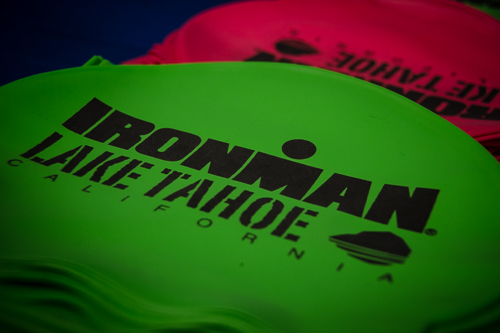
The event is sought-after and sold out within a few hours. My credit card is already in pain – I am, on the other hand, full of anticipation. Anticipation about the upcoming months that will be filled with training and preparation. Determination paired with the willingness to leave the comfort zone, again and again, are fore sure a persevering and indestructible part of my genetics.
12 months and countless training miles later…
No, I don’t want to emigrate, although my luggage looks like that’s the plan; the bike container alone weighs 23 kg (51 pounds). After 10 hours on board of an A380, we arrive in San Francisco.
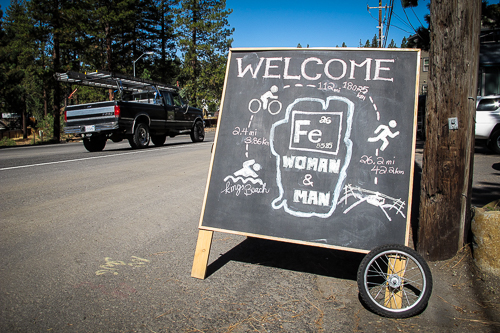
At the very end of a long line, a Homeland Security officer checks our passports. How long we plan to stay. – Four weeks. What the occasion of our stay is. – The IRONMAN in Lake Tahoe, plus the marathon in Lake Tahoe a week after that: Natascha, my daughter, will be volunteering at the IRONMAN and supporting me on race day. One week later, she will be running her first marathon and I will do my best to support her. “Good luck and have a safe trip”, he says and off we go.
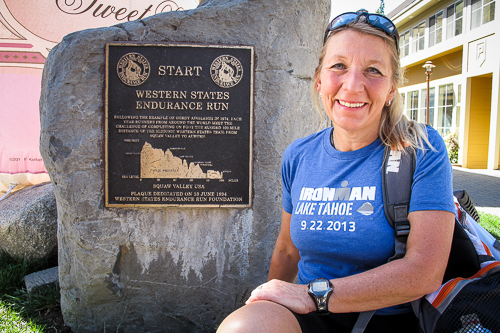
Finally, we are in California. We are not Hollywood-bound; neither do we care for the Golden Gate Bridge. It’s bumper-to-bumper traffic as we try to leave the Bay area in our rammed up rental car. Four hours later, we reach the famous Lake Tahoe skiing area. The air gets thinner, and we arrive in Truckee. The small town is located at 5976 ft. (1.822 m) above sea level and is the perfect place to get used to the elevation. We will stay there for the next 6 days.
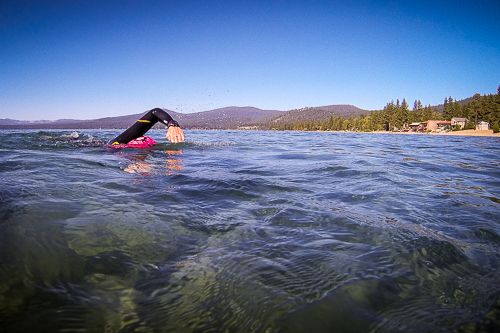
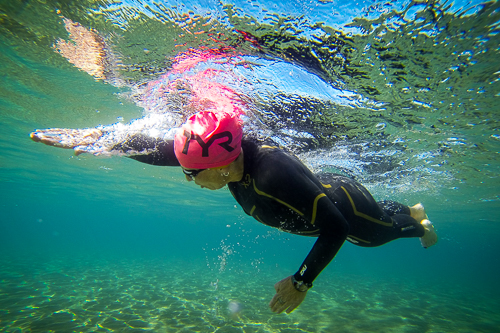
Only 2 days to go…
The obligatory briefing takes place in Squaw Valley. Squaw Valley is one of nine skiing areas at the northern end of Lake Tahoe and was site of the 1960 Winter Olympics.
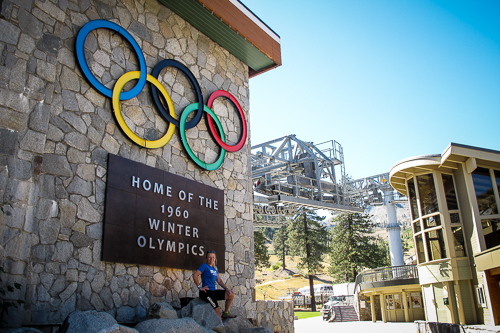
I was not even born when Heidi Biebl from the Allgäu won the women’s downhill, and the German pair Marika Kilius and Hans-Jürgen Bäumler won a silver medal in figure skating. Today, Squaw Valley is the Athlete’s Village. It is the Friday before race day, the air is brisk but the sun radiates over the surrounding mountains and the huge square with the expo tents.
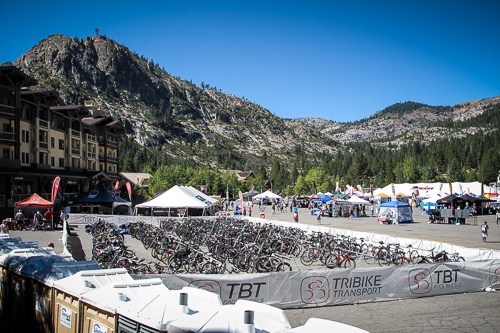
In one of the tents, I pick up my bib, together with a wristband, a pink swimming cap, the athletes guide and an IRONMAN backpack. Everyone wishes me good luck for race day, and I am off to some excessive (race merchandise) shopping. Later that day, the 2700 participants, friends and volunteers meet up for the Welcome dinner. After some salad and pasta, it is getting very celebratory with the national anthem sung live and the celebratory speech because 2013 marks the 35-year anniversary of IRONMAN. In 1978, for the very first time, 15 (only male) participants went off to find the most persistent athlete among them.
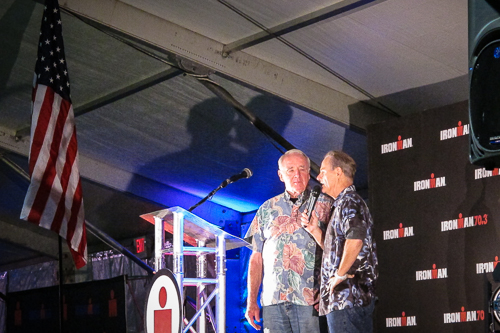
Tonight, John Collins who is dressed in shorts and Hawaiian shirt enters the stage. His hair is grey, his eyebrows blonde. He looks like he came straight from the “Dallas” set. It turns out that in 1978 he was a Navy Commander and one of the first IRONMAN participants. Back then, he paid 70 dollar for his race bike and 5 bucks for the race entry. His finishing time was over 12 hours and he ended up being second last. Today, every (full) IRONMAN race has a 17-hour time limit, only in Frankfurt at the European Championships it is one hour less. But that is a different story.
Back in the Here and Now, another extraordinary participant is introduced: He will be doing his 99th IRONMAN. The entertainment program ends, and the formal briefing starts.
Seeing Bears and meeting deer
Gels, energy bars or even water bottles are not allowed at the bike drop-off – they could attract bears. Conclusively, every athlete gets five bags: A white one, so-called “smoking bag” for the post-race stuff like clothes or special snacks. A red one for the bike clothes and a blue one for everything desired for the run. The two extra ones, “special needs” bags are new and have never been used in an IRONMAN before. Those are for gels, energy bars, or anything else food related. Every bag except for the smoking bag has to be handed in on Saturday.
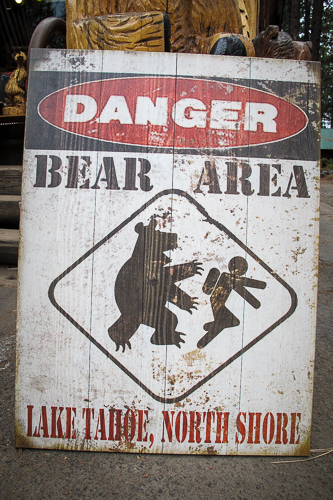
The nature surrounding us athletes is, despite the few spots of civilization, insistent and overpowering; the vast vegetation with its rivers and lakes, surrounded by forests and mountains ubiquitous. And in fact, a few days later a black bear crosses the street right in front of our car as we drive down the serpentines to Yosemite Valley.
One day to go…
The sapphire blue Lake Tahoe is one of the favorite travel destinations in California. Here, at the northern tip of the Mountain Lake, no one plays his luck. Those who can afford to live here are lucky already. Everything is a little bit more genteel, reserved and steeped in history.
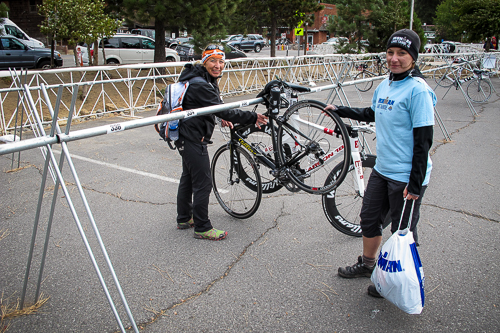
Bike check-in: The classic show-off of well-trained and tanned bodies begins. Today, everything is different. Instead of lean and bronzed legs in shorts and reflecting sunglasses, you can see athletes wearing long (thermo-) pants, rain jackets and beanies. Until yesterday, the wildfire risk was extremely high whereas today fierce winds turn the Lake into troubled waters. The wind blows forcefully through the pinewoods along the shore, and only one sole kite surfer defies the chilliness and glides across the Lake.
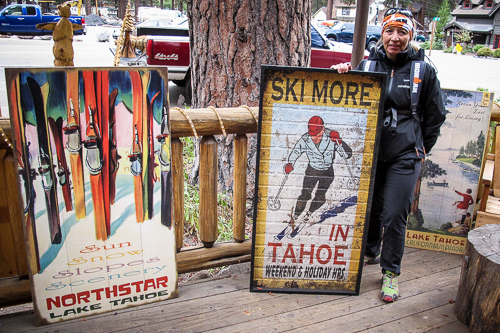
California does not necessarily mean summer, warm temperatures and sunshine: It is pouring and it won’t stop.
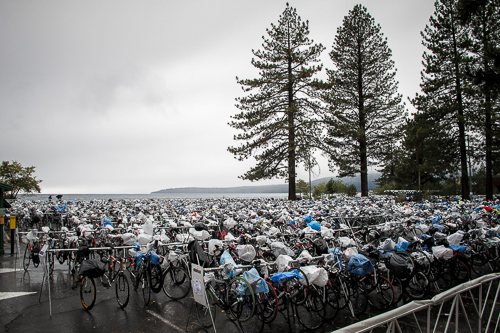
Our bikes are soaking wet. In the transition area, the bags are lying in puddles and the atmosphere is icy and everything but IRONMAN-attuned. Repeatedly, I ask myself how many layers I should wear tomorrow and what I am going to do when it is getting dark and colder after hours in the race.
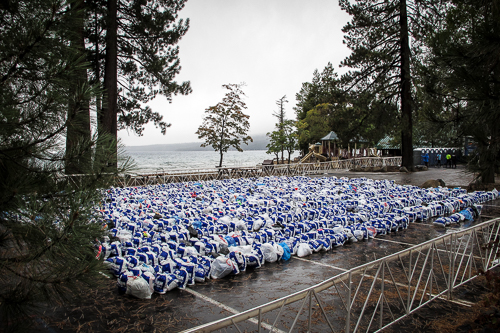
Pre-race evening
Just like sheet lighting during the night, I start to feel the cardiac arrhythmia coming up again. It has become a solid part of my (training) life for years now and I am used to it. Sport strengthens the heart. For me, that means a resting pulse of 40 bpm – not enough at the discretion of my cardiologist. Sometimes, the nagging question about the pros and cons of such a challenge remains. Listening to the even drops from the bathroom tap, I keep checking my watch. Again and again. What am I doing to my body? The night is short and bitter cold. I am dreaming about this race for months, and now this dream appears to come to nothing because of the weather. Impossible! Out of the warm bed and into the neoprene wetsuit. Inch for inch, I jiggle myself into the expensive and (today absolutely) vital second skin. At this point, I would like to thank my mom for getting me this wetsuit! On top of the wetsuit, I put on long pants, thick socks, two long-sleeve shirts, a wool beanie and gloves. With the exception of a coffee, I cancel breakfast. I am feeling nauseous.
It is 3 am, I am tired and I feel miserable. I have a headache and palpitation – from not only the elevation or excitement.
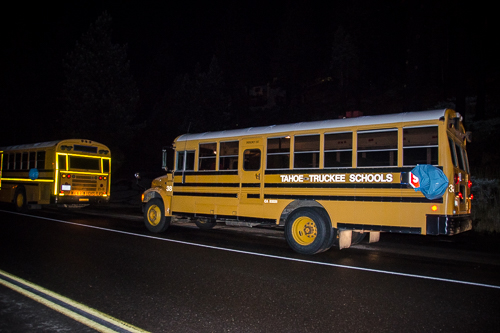
It is 4 am and way before the break of dawn. The thermometer shows -2°C (28 °F) but at least it has stopped raining. Half a dozen yellow school busses are waiting in Squaw Valley to take the athletes and spectators to the starting line in Kings Beach. Packed in tightly, we sit in one of the busses as if we were all on a skiing trip. It is still dark outside, the shops and restaurants are closed. After dozing off for another 30 minutes, the bus arrives at Kings Beach and I am wide-awake. Glaring spotlights illuminate the athlete’s area.
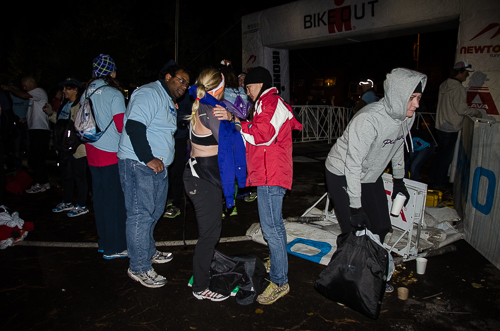
Before I even realize what’s going on, someone picks at my pants and asks me about my age group. Moments later, my calves are marked and if that is not enough, I get another marking on my upper arm. Race bikes – as far as the eye can see. I marvel at the sight of one particularly impressive carbon-steed. What was once the shiny coat of a horse are now raindrops on expensive race bolides. Among all these delicate bicycles, my soaking wet bike looks like a prairie tank.
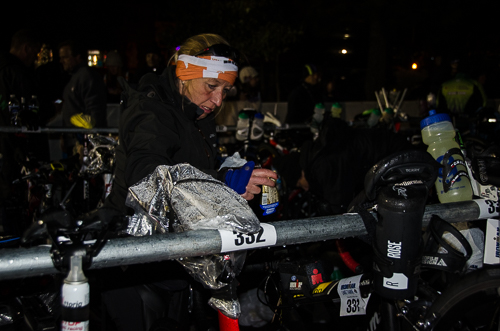
The bike owners start posturing, vain like many Hollywood stars; some really dig deep in their pockets for this sport. For this glamorous item, the adorning supplement and object of desire some spent a 5-digit amount.
However, there are no protective covers against the rain. My bike rather equals an American SUV – an athletic utility vehicle. My little Italian is rather outdated but has suffered with me, was thrown in the corner more than once yet never has forsaken me. So many IRONMAN-heroes tell their stories about burst tyres along with their burst Kona dreams. What is the fanciest material worth when the body does not want to take another step eventually? Only then, during the marathon, and when there is no material left to show, the raw brutality of an IRONMAN becomes apparent.
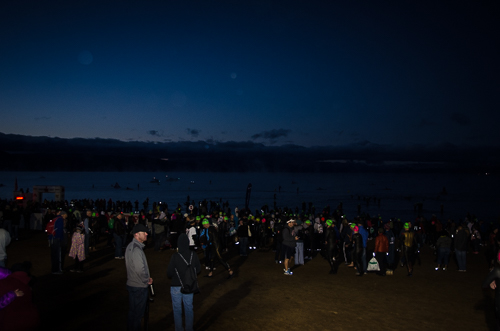
The Lake is still covered in darkness and the buoys swallowed by the dense fog. The swim is about to start. I cover my head in not only one but two layers of latex. I am always lucky with the cap color so today, as always, I am wearing pink. Men are wearing bilious green. Only 10 more minutes to go…
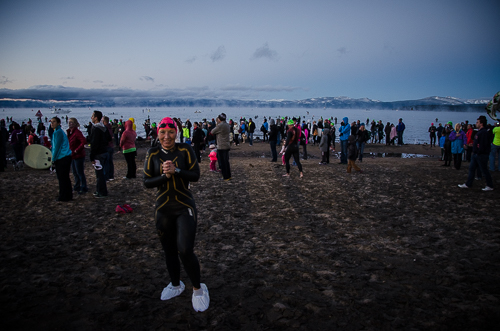
“10 minutes to go”, it sounds from the speakers; the starting gun for the pro athletes goes off. The 2.700 age group athletes and endurance enthusiasts move botryoidal from the bike transition to the beach. The youngest participant just turned 21; the oldest is born in the 1940s. Never before in an IRONMAN race have there been so many female participants, and the participants in my age group surpass any image of well-trained women beyond their 50s. There were 17 women in my age group at this year’s IRONMAN Frankfurt whereas today I am competing with 98. Today, we are not competing against each other; today’s race is a fight against ourselves.
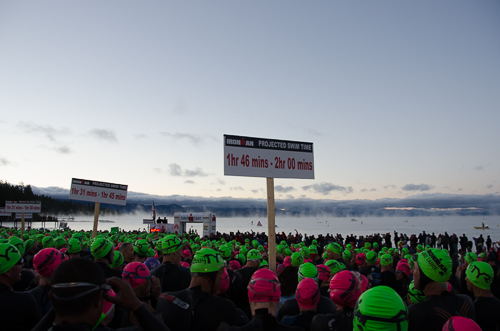
Even the pro athletes are cold
Very big, very deep, very calm, very foggy, very beautiful and very, very cold. Massive, partially snow covered mountains frame the Lake at the border between California and Nevada. Lake Tahoe is about 15km² (5.8 mi²) bigger than the biggest German lake, Bodensee, and with a depth of 1,645 ft. (501 m) the second deepest lake in the United States. It is said that the water is so cold that the corpses of cowboys who drowned in the lake over a century ago, are still in very good condition when retrieved.
The water is calm and the turn buoy barely visible in the rising mist. The sight of the widespread lake evokes a mood, which inspires respect and admiration for the hours ahead of us. The Lake is, with a surface elevation of 6,225 ft. (1,897 m), also the largest alpine lake in North America. The high elevation combined with the cold temperatures makes the swim even harder.
Rolling start instead of mass start
In the recent IRONMAN past, several athletes were injured, or even died during the swim start. On that score and for the first time this year, the World Triathlon Corporation (WTC) reformed the regulations for the swim: The buoys are now numbered, and firmly anchored, and they increased the numbers of rescue workers along the swim course.
Some might say: “There are only two types of triathletes who don’t get beaten around in the water. The guy in the lead and the last.” This, next to safety intentions, may be another reason for the so-called “rolling start”. This means that the timekeeping starts only after the athlete has crossed the timing mat.
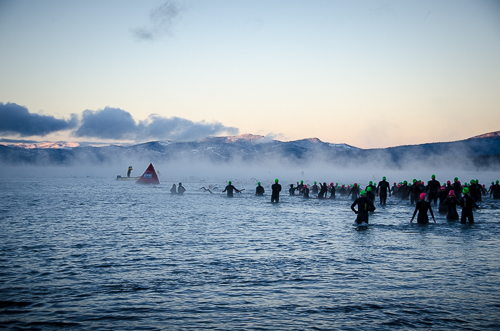
It is a morning like straight from a storybook: its 6:28 am. A lovely voice sings “The Star-Spangled Banner” and it suddenly gets quiet among the tense athletes. After that, everyone is restless. Before the morning sun has fully risen above the pine treetops, the redeeming starting signal resounds over the beach. The fascination and chill of the moment is unique. The cluster of athletes slowly moves towards start tower and timing mat. Not until the last second, the athletes keep on their socks, flip-flops or hotel slippers because the air, just like the sand, is freezing cold.
I hug Natascha one last time and take a deep breath; the water is like a wakeup call for my blood cells. The water slowly flows through my wetsuit and for a short time cools down my emotions. Time is running – we have to swim two laps and counter clockwise. Along the beach, spectators, family and friends, sponsors and volunteers are cheering on us. I am doing breaststroke, too afraid to submerge my head in the cold water. Eventually, my arms start propelling timidly through the water but I am still afraid to choke on the cold liquid. I just want to make it through the swim safely. Despite the cold, I am starting to enjoy myself. The picture of the snow-covered mountain range of the Sierra Nevada rising from the sea of fog is mesmerizing and not of this world.
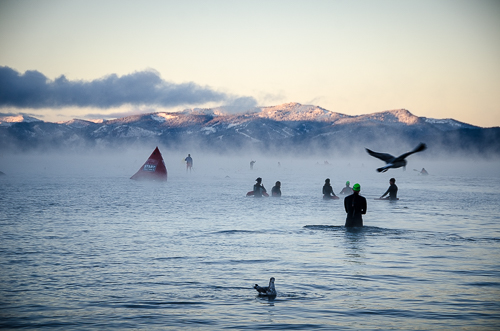
The first beams of sunlight meet the White of night frost and gilds the buoys in front of me – at least for a few moments. The sun warms my back as I see and feel the water getting deeper and colder at the same time. This underwater sight would make every gold fish go crazy. Not rushing, just going along like driftwood – that is my plan. Dust rises from the waters and not only the wind makes little ripples spread out across the water. Below the water surface, the athletes in their black neoprene skin act like a startled shoal of fish. Above the surface, the muscular athletes beat down everything standing in their way with strong strokes – driftwood, too. Bravely, I try to adjust myself among the milling mass of twitching marine creatures, swimming in their backwash to make a fast progress and to stay safe at the same time. Sporadically, I lift my head to aim at the next buoy, and soon I am already halfway through the swim course.
Land in sight
Through my googles, I see a swimmer being pulled out of the water and into a rescue boat. The adrenaline is rushing through my blood. Of course, everyone reaches their low at a certain point in such a tough race, and of course, some of us ask ourselves, why we are doing this to our body and mind. Luckily, I find my own rhythm and start to enjoy myself more and more – and I start to understand why long distance swimmer love what they do: It’s the unlimited scope of water, swimming in raw nature, no poolside or black lane on the ground. It is the experience of the crystal clear water below me and it feels like the boundary between dreams and reality becomes even more blurred. I think about the countless training miles I spent in the public pool.
Today, I do not care for style perfectionism and the ideal plunge angle; my arms are getting heavy. It is always the same, the same waves and wrinkles. Only a few hundred meters left, the shore comes closer.
Crashtest Dummies
As beautiful as the lake is today, everyone wants to get out of it as soon as possible. Little by little, the athletes arrive at the lakeside. After 1:28h (that makes 43th in my Age group) I am, too, finally out of the water. I sprint into transition and to my bike bag. Without the help of the volunteers, most of us would’ve been totally lost; it’s chaotic and everyone looks for their bag among thousands of other similar looking bags. Rapidly, a volunteer hands me the bag and I rush into the changing tent. Before I realize what is going on, two wet suit strippers already help me take off that second skin. Flayed and freezing, I am trying to find a free spot in the dark and crowded tent but there was no chance of getting a seat.
I am completely stunned by the hustle and bustle in the tent as I try to get my wet body into three layers of clothing. Another volunteer is trying to help me but my clothes are cold and damp. The bag was laying on the rain-slicked ground, the cord is even frozen. Luckily, I put the bag into another bag in order to keep it as dry as possible.
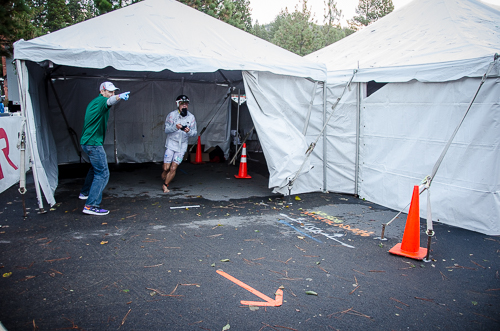
In a triathlon, it usually goes like this: Those who put on a one-piece in the morning will not be getting out of it any time soon but most likely after the finish line. Today, everything is a little bit different. Today, everything is a little bit more elaborate – and the time is running. My fingers are cold and I can barely feel a thing. There are still many athletes out there in the lake and not a few are falling by the wayside due to the weather conditions. Incredible 18 minutes pass until I finally get on my bike. In comparison, it took me just 6 minutes to get from the swim to the bike at the IRONMAN in Frankfurt last year.
Up, up and away
The bike course starts with small rollers and I am west bound for the next 9 miles until Tahoe City with the Lake always in sight. The Lake is surrounded by lofty peaks, which are covered in white powder and enclosed by deep green and rustling forests. The distinctive cerulean of the water fascinates me although my wet ponytail is annoyingly dripping on my back. The course then gently rises.
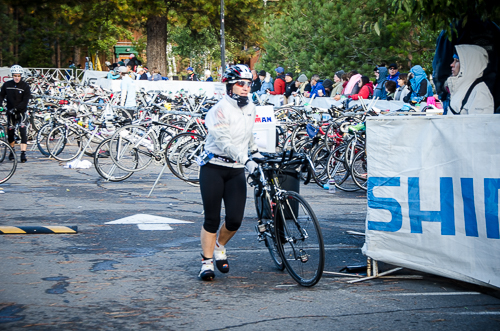
I am warming up slowly. I am busy checking my physical condition: heart rate, respiration and nutrition. My PowerBars are ice-cold, rock-hard and I am afraid to break off one of my tooth. At Highway 89, the Truckee River peeps out through the bushes and trees. Easily, I am rolling through the 140-year old small town of Truckee, which was founded as outpost of the Central Pacific Railroad, principal axis from coast to coast. Truckee became famous as a location for movies such as Charlie Chaplin’s “The Gold Rush”, or James Cameron’s „True Lies“ starring former governor of California Arnold Schwarzenegger. Just like in the good old west, the late 19th and early 20th century wooden houses line up along the main street. After 36 miles, the course leads into the mountains and out of my comfort zone.
Private Party (North Star)
I bike along the Northstar Drive. The climb to the top of the high-class ski resort is almost as steep as the ascent to the highest point of the entire bike course at Brockway Summit. I lift my butt from the saddle and keep pedaling upward. Breathing heavily, I try to maintain a stable speed while enjoying the smell of the pine trees around me. At 6.800 ft. (2.072 m), we pass under the Northstar gondola.
Nobody has a bike bell today – or mercy. Because everyone is suffering. I am focused only on my thighs. I switch into the lowest gear possible using my third chain ring – they call it life ring for a reason. My speed after 10 minutes: a total of 5.6 mph (9km/h). My heart is beating fast when I reach the summit. Relieved, I enjoy the fantastic view over the valley.
At the second pass, I almost fall off my bike out of sheer amazement as I pass a well-trained athlete with small head in a huge aero helm on his disk-wheeled Carbon racer easily. I am now at the foot of the highest peak of the course, Brockway summit at 7.209 ft. (2.197 m), where it snowed yesterday. Of course, my determination to get up there is strong enough but do my legs know that, too?
I keep pedaling in the lowest gear. Average pace: 5.5 mph (8,9 km/h). I take in the fresh air; I eat and drink. That is easy as long as you are not a picky eater: A gel, or PowerBar every hour, plus something isotonic, and some water because if you feel hungry or thirsty it is probably too late.
The road in our driving direction is closed for vehicles but on the opposite lane, the driver of a huge motorhome is waving at me. After another ascent, I am happy that my fight with gravity is over for now and I revel with 37.3 mph (60 km/h) the 3-mile downhill stretch. The first lap is over.
The last 40 miles of the second lap until the bike finish feel like 100 miles. In addition, I am damned to pedal up the last ascent with a maximum pace of 6.8 mph (11 km/h). I keep my head down; I do not even want to look at that hill. I gasp for breath; I could not talk even if someone was there to talk to. The wind, the mountains and the thin air make for a truly dramatic trio. Only one of these three would make a great opponent, but together… The wind dashes against my helmet and sweeps the dust from the street right into my mouth. So far, my heart rate is not dramatically high and my heart seems to be doing okay, too, only my feet and back part hurt.
Transition in Squaw Valley
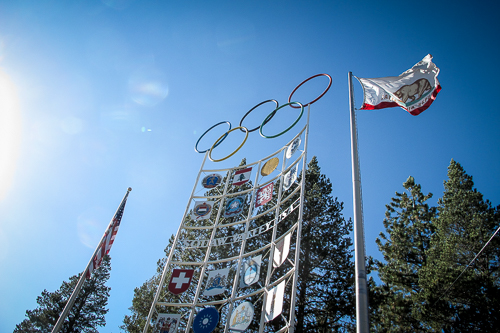
At the entrance of Squaw Valley, the everlasting Olympic torches greet me. I finish this breathtaking and spectacular bike course through one of California’s most beautiful skiing areas in 7:34 h (17th in my AG).
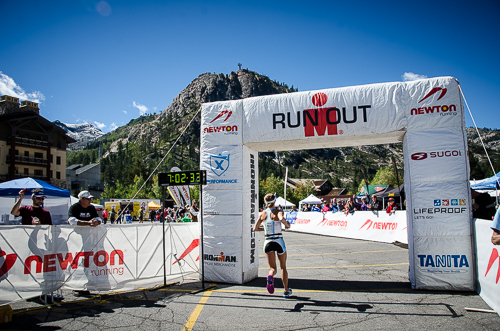
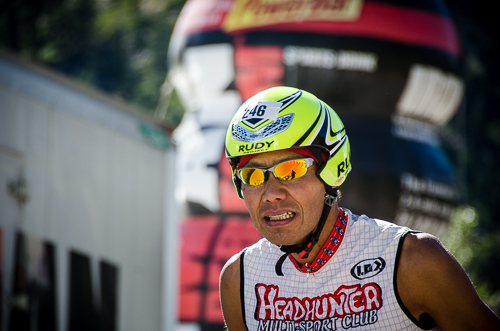
After a 2.4-mile (3,8km) swim and 112 miles (180km) on the bike, this is just the beginning: the beginning of a marathon. At this point, my will is indomitable. But what about my body? I am exhausted; the thin air takes a toll on my body. Stiffly, I carry myself into the changing tent. A volunteer hands me my bag. My feet hurt but there are enough benches in the tent and I am glad to be able to sit down for a while. Another volunteer empties my bag in front of me and I am thrilled to find a can of cold espresso in it. After the last hours, this liquid salvage along with a moment of rest is exactly what I need.
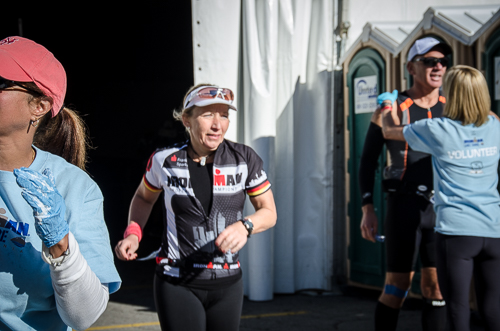
Slowly, I get up again. Next up is long jog for hours on end – at the best. The course is two laps along the valley trail, back up the Truckee River corridor along the Truckee River bike lane and through the village center, passing by the finish line twice.
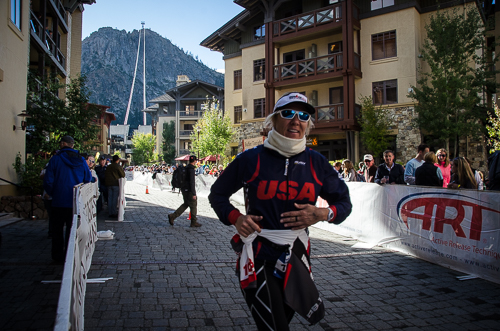
I hear spectators cheering as I start my way along Squaw Valley Road and next to Highway 89. At this part of the course, one can see other athletes on their bike as they approach Squaw Valley. The cut-off after the bike is 11 hours.
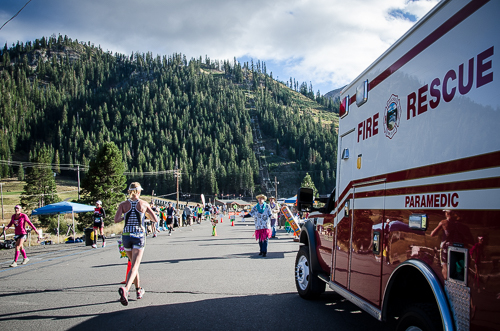
After 1.5 miles, I arrive at the first aid station. They have gels, cracker, fruit, water, iso, coke and chicken broth. I start having stomach and circulatory problems, so I decide to continue at a slower, more comfortable pace.
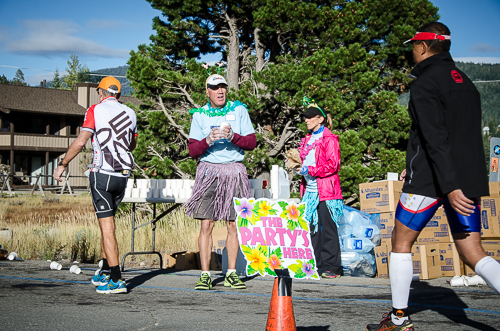
The course leads 6 miles straight lengthways the Truckee River and by pines that sway in the wind. After a 180-degree turn, the course then leads back to Squaw Valley. Throughout the day, I observe the light: how it changes and how it is turning smooth now. The asphalt beams under the last flickers of sunlight and those rays seem to chase my long shadows over the way in front of me. I can see in the faces of those running on the other side of the course. Mirrored sunglasses hide the exhaustion und eyes contorted with pain. Today, all fights are fought – everyone just wants to cross the finish line.
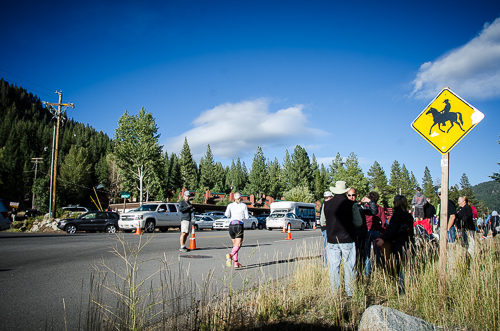
For the second time, I arrive at the town center in Squaw Valley and see the chute. I see and hear athletes finishing, hear the crowd applauding. One last time, and for a shorter second lap, I leave the town behind me and continue running on the bike path along the River. It is getting colder and I do not want to think about the upcoming darkness.
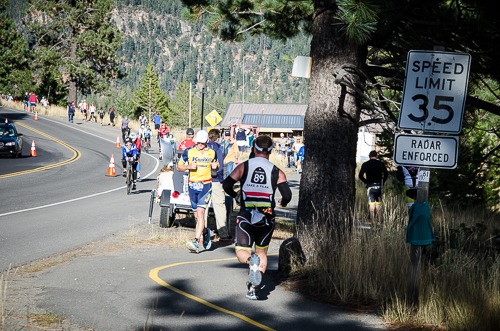
However, I keep walking slowly; my fingers, stiff because of the cold, clasp the paper cup with hot chicken broth.
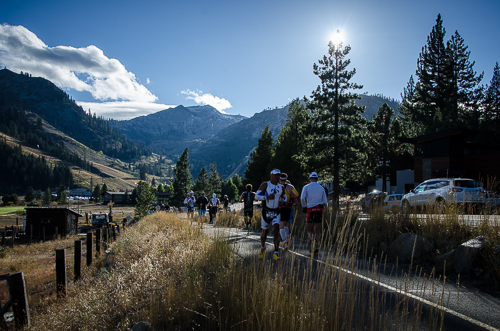
After the 180-degree turn, the course heads back to Squaw Valley again. It is getting darker and colder with every step. Everyone who is still out on the course glimmers palely through the night. Finally, I see Natascha, she takes some pictures and we talk a bit. I have less than 3 miles left until the finish.
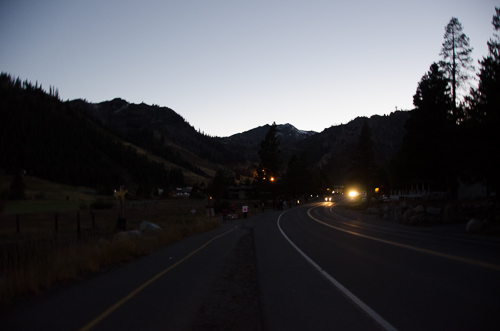
Already in the chute and only a few feet from the finish line, I slow down. The oversized numbers of with my time flicker through the dark: 14:27:04. Never have I ever been so slow during an IRONMAN. Placing and finish times do not even count for many athletes. They only have Kona slots for the best in each age group – in fact, only one Hawaii slot in my age group.
Thus, I am even more pleased to see that I was 376 of all women after the swim but finished on place 172. That makes 10th out of 98 women in my age group. Too slow for Kona: curse or blessing? Considering the entry of 825 US Dollar, I am actually not that sad.
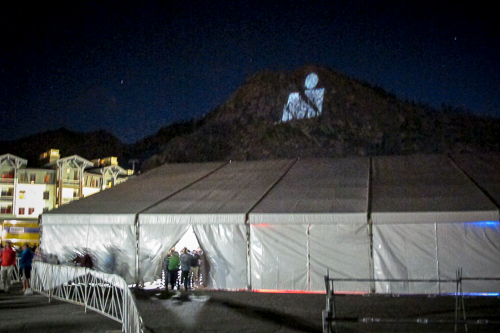
DONE! Tackled. Finished!
Natascha is volunteering as catcher and waiting for me right behind the finish line. Tears of joy, devitalized hugs, exhausted but happy faces everywhere you look. Here, in Squaw Valley, my personal American dream becomes reality. Someone hangs the heavy metal around my neck. The M-dot illuminates the 9019 ft. (2.749 m) high Granite Chief on the other side of the valley. Pride and exhaustion illuminates the finisher’s faces. Trembling from the cold, I say a prayer, thankful that I did not drown in the lake and that my trusty bike carried me all the way through the bike course.
20 % DNF
The average finishing time was 14 hours and 6 minutes, whereas 20% of the entire field did not make it to the finish line. The DNF rate on the bike course was 12% and 8% on the run. Every athlete was struggling with the low temperatures, the elevation on the bike course, or the altitude in general. This may be some of the reasons why this event has the second highest DNF rate in an IRONMAN worldwide.
First day post-IRONMAN and I feel great. No particular pain or unusually sore muscles. Now we have to pack our bags and get ready for Hiking and Relaxing at Yosemite National Park because in 7 days from now, I will be standing at the starting line of my daughter’s first Marathon, the Lake Tahoe Marathon.
Footnote: What can I do for my next birthday? Maybe another IRONMAN? – No, definitely not! But it is still allowed to dream, right…

